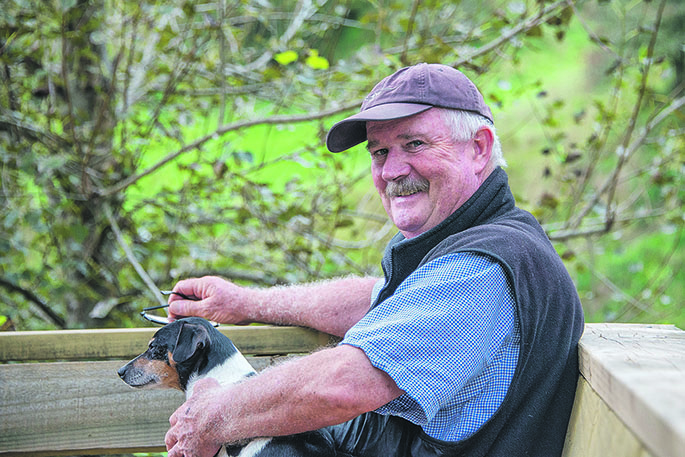Waipa landowner Ian Kerr shows that with vision, determination and a good deal of ‘Kiwi can do’ attitude, 22 hectares of gorse-covered Waikato gully can be transformed into an environmentally-conscious, profitable business. This hardworking businessman has made the most of all the property’s different attributes and has several different ventures on the go.
From the early-1990s, Ian would have been found on Nananu-i-ra, a 3.5km2 island just off the northern coast of the main Fijian island of Viti Levu. At the time, the privately-owned island was farmed, and had some residential areas. About 800 acres of cleared bush provided grazing for beef and sheep. This idyllic spot was leased and farmed by Ian for about 15 years.
“We had a flock of self-shedding ‘Fiji Fantastic’ sheep,” says Ian, “Specifically for the Indian population of Fiji, who can’t eat beef. The cattle were a Santa Cruz-Brahman-cross, the perfect mix for good meat production and resistance to the heat.”
Farming an island with no proper roads and no fresh water supply was challenging at times. Ian’s entrepreneurial skills at utilising what you have also came to the fore during his years in paradise. Alongside the farming, he started a resort on the tiny island.
“By ‘resort’ I mean some rustic-style barns with dormitories,” he says.
Bare land
This quickly expanded to include surfing, kite boarding and a dive school. The resort became known as ‘Kiwis in Paradise’ and was a favourite way of experiencing the beauty of the island on a budget.
During his time in Fiji, Ian met his partner Judy and started a family. When Nananu-i-ra was sold in 2004, they made the decision to return to New Zealand for their girls’ education.
Their choice of property back in NZ was interesting. The 22ha of bare land close to Lake Karapiro seemingly had little to offer, with no road access, streams and gorges throughout, and was infested with gorse.
“It was a block of scrub and had a school next to it,” Ian says.
He saw the potential of the property as an adventure/tourism business, and much more. Looking at the property through Ian’s eyes, and feeling his enthusiasm for it is inspiring. As you drive around, bouncing along in a four wheel drive, up and down steep tracks and splashing through stream beds, Ian points out the gorges, cliffs, waterfalls, trout streams and their very own glow worm canyon. Sitting in the ultimate man cave, a rustic bush hut he built, Ian explains how his vision came to life.
The first thing built was a 48m by 24m shed with an apartment above it, and a huge lockup area where Ian planned to build a motorhome. A casual enquiry about group accommodation changed things very quickly. Today they have a training facility and accommodation for large groups, with bunk rooms, a commercial kitchen and ablution blocks.
“It’s all compliant with council,” says Ian, a little ruefully. “We started with no mortgage, now we’ve got a good one.”
Outdoor activities
Ian’s management plan for the land is simple. He initially cleared the gorse by digging it out using a digger, and burying it deeply. Maintenance weeding is done by hand, often by one of the regular WWOOFers – World Wide Opportunities on Organic Farms workers – and no sprays of any type are used.
About 30 acres of pasture was drilled on the flatter areas and initially Ian grazed heifers. Hundreds of trees were planted. Several kilometres of vehicle access and walking tracks were formed so all areas can be reached. Ian tries to leave things to happen as naturally as possible unless there is danger to humans or a building.
“I can always tell when a big tree is about to fall,” he says. “A few months before seedlings will start to grow under the tree and you can guarantee the tree falls soon after.”
Ian uses this natural wilderness for numerous outdoor activities, either for team building or to groups who come in and run their own activities such as airsoft or 4WD vehicle courses. The latest venture is an adrenalin-pumping 500m zipline. Next on the agenda is to prepare one of the natural cliffs for certified abseiling and climbing courses.
The waterways, springs and bores produce clean, pure water that only requires filtering. The waterfall’s power has been harnessed with two micro hydros – a type of hydroelectric power that using the natural flow of water – producing enough electricity to run the apartment. But another power source is required during low summer water levels. Ian would love to get a solar system installed. Harking back to the days in Fiji, he also has a wind turbine, but it is only a minor contribution as the property is not very windy.
Ian also spends about 20 hours a week running a hydroponic vegetable enterprise on the property and selling the produce at local farmers’ markets.
The “rest” of the time Ian is busy with building and property maintenance, supervising the groups that come and go, and organising catering, cleaning and laundry. But you can guarantee he still finds time to go and reflect with a beer or two, in the solitude of his bush hut by the stream.
Next edition Coast and Country News will explore the workings of Ian’s hydroponic vegetable enterprise.



0 Comments
Leave a Comment